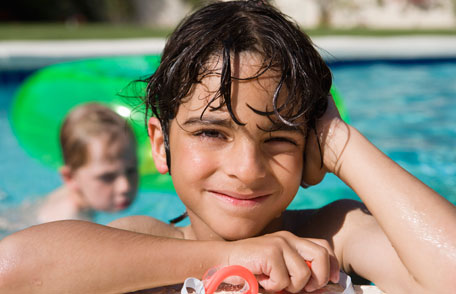Last Updated on January 22, 2024
Pools, waterparks, hot tubs/spas, splash pads, and water playgrounds are great places to have fun, be active, or just relax. Having fun while you swim this summer means knowing how to stay healthy and safe while enjoying the water!
Swimming is one of the most popular sports activities in the United States.1 And just 2.5 hours of water-based (or other forms of) physical activity per week has health benefits, we each need to do our part to minimize the risk of illness and injury.
Make a Healthy Splash: Share the Fun, Not the Germs
Swimmers, parents of young swimmers, aquatics and beach staff, residential pool owners, and public health officials can minimize the risk of recreational water illnesses (RWIs).
Prevent Illness
RWIs can be caused by germs spread by swallowing, breathing in mists or aerosols of, or having contact with contaminated water in swimming pools, hot tubs/spas, water playgrounds, lakes, rivers, or oceans. RWIs can be a wide variety of infections, including gastrointestinal, skin, ear, respiratory, eye, neurologic, and wound infections.
Most outbreaks linked to the water we swim, relax, and play in are outbreaks of diarrhea. These outbreaks are caused by germs like Crypto (short for Cryptosporidium), Giardia,Shigella, norovirus, and E. coli O157:H7.
These germs—sometimes millions at a time—can spread when someone who is sick has diarrhea in the water. Other people can get sick if they swallow the germy water—even just a mouthful.
Pool chemicals, like chlorine or bromine, are added to the water to kill germs. But they don’t work right away. If used properly, they can kill most germs within a few minutes. However, some germs, like Crypto can live in properly treated pool water for several days.
The job of pool chemicals is to kill germs. But when pee, poop, sweat, and dirt rinse off our bodies and into the water, the chemicals break down these other things instead of killing germs. This uses up the chemicals’ power, which means there’s less to kill germs.
Remember, we share the water—and the germs in it—with everyone. To help protect yourself, your family, and your friends from germs, follow these easy and effective steps each time you get in the water:
Keep the pee, poop, sweat, and germs out of the water!
- Stay out of the water if you have diarrhea.
- Shower before you get in the water.
- Don’t pee or poop in the water.
- Don’t swallow the water.
Every hour—everyone out!
- Take kids on bathroom breaks.
- Check diapers, and change them in a bathroom or diaper-changing area—not poolside—to keep germs away from the pool.
- Reapply sunscreen.
- Drink plenty of fluids.
Order your FREE Healthy Swimming brochures and pool chemical test strips today.
Check the free chlorine level and pH before getting into the water.
- Pools: Proper free chlorine level (1–3 mg/L or parts per million [ppm]) and pH (7.2–7.8) levels maximize germ-killing power.
- Hot tubs/spas: Proper disinfectant level (chlorine [2–4 parts per million or ppm] or bromine [4–6 ppm]) and pH (7.2–7.8) maximize germ-killing power.
- Most superstores, hardware stores, and pool-supply stores sell pool test strips.
FREE Healthy and Safe Swimming Resources
- CDC Healthy Swimming brochures (available in English or en Español)
- CDC Pool Chemical Safety posters (each available in English and en Español)
- Water Quality & Health Council (WQHC)’s Healthy Pools page.
Remember: Think Healthy. Swim Healthy. Be Healthy!
References
- US Census Bureau. 2012 statistical abstract of the United States. Recreation and leisure activities: participation in selected sports activities 2009 [152 KB]
Source URL: http://www.cdc.gov/features/healthyswimming
Source Agency: Centers for Disease Control and Prevention (CDC)
Captured Date: 2013-12-11 21:36:06.0







